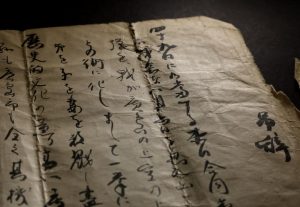Documenting Hiroshima of 1945: September 23, eulogy at community funeral held “49 days” after A-bombing
Sep. 23, 2024
by Kyosuke Mizukawa, Senior Staff Writer
September 23, 1945, marked the 49th day after the atomic bombing on August 6. A local residents’ association in the area of Kogo-honmachi, Hiroshima (in the city’s present-day Nishi Ward) held a community funeral for A-bomb victims in conjunction with the conclusion of “49 days” of mourning following their deaths. According to the Record of the Hiroshima A-bomb War Disaster, published in 1971, Buddhist priests from three temples in the Kusatsu district (also in Nishi Ward) chanted Buddhist sutras to comfort the “spirits of 45 souls.”
The Hiroshima Peace Memorial Museum has in its archives the eulogy made by Toshimaru Yasumitsu, 44 at the time, then chair of the residents’ association who died in 1993 at the age of 92. The eulogy read, “On the occasion of the joint funeral today, the 49th day after the A-bombing, we cannot help but recall the tragic and unfortunate day of August 6 … The A-bombing turned Hiroshima into a city of death and ashes, massacring tens of thousands of defenseless, innocent people — our parents, siblings, children, and wives — all at once.”
Although Kogo-honmachi, located more than two kilometers from the hypocenter, was spared destruction from the fires, local residents who were in the downtown area because they had been mobilized for work or for other reasons were killed in the bombing. Mr. Yasumitsu lost his oldest son, Kazuo, 14 at the time, who was a second-year student at Sotoku Junior High School. Kazuo had been mobilized to engage in building-demolition work for the creation of fire lanes.
Bodies drifted ashore on the banks of the Yamate River (now a diversion channel of the Ota River) in the Kogo district, near the mouth of the river. Mr. Yasumitsu had cremated unidentified bodies of young boys on the embankment. In his eulogy he read, “Tears flow endlessly and my heart breaks when I think of those who died while being watched over by their families, those who returned as bones bleached white, and those who have yet to return.”
He also touched on the reality of the suffering in the eulogy, lamenting, “Even today, many people are losing their precious lives due to decayed wounds and diseased internal organs caused by poisonous gases that were emitted at the same time as the intense thermal rays.” He concluded by saying, “We are indebted to those who died in the war. May they all rest in peace.”
The Hiroshima City government set up an altar in front of City Hall in conjunction with the 49th day after the bombing. Memorial services were held for victims, including unidentified remains kept in the government offices and other remains still buried throughout the city.
(Originally published on September 23, 2024)
September 23, 1945, marked the 49th day after the atomic bombing on August 6. A local residents’ association in the area of Kogo-honmachi, Hiroshima (in the city’s present-day Nishi Ward) held a community funeral for A-bomb victims in conjunction with the conclusion of “49 days” of mourning following their deaths. According to the Record of the Hiroshima A-bomb War Disaster, published in 1971, Buddhist priests from three temples in the Kusatsu district (also in Nishi Ward) chanted Buddhist sutras to comfort the “spirits of 45 souls.”
The Hiroshima Peace Memorial Museum has in its archives the eulogy made by Toshimaru Yasumitsu, 44 at the time, then chair of the residents’ association who died in 1993 at the age of 92. The eulogy read, “On the occasion of the joint funeral today, the 49th day after the A-bombing, we cannot help but recall the tragic and unfortunate day of August 6 … The A-bombing turned Hiroshima into a city of death and ashes, massacring tens of thousands of defenseless, innocent people — our parents, siblings, children, and wives — all at once.”
Although Kogo-honmachi, located more than two kilometers from the hypocenter, was spared destruction from the fires, local residents who were in the downtown area because they had been mobilized for work or for other reasons were killed in the bombing. Mr. Yasumitsu lost his oldest son, Kazuo, 14 at the time, who was a second-year student at Sotoku Junior High School. Kazuo had been mobilized to engage in building-demolition work for the creation of fire lanes.
Bodies drifted ashore on the banks of the Yamate River (now a diversion channel of the Ota River) in the Kogo district, near the mouth of the river. Mr. Yasumitsu had cremated unidentified bodies of young boys on the embankment. In his eulogy he read, “Tears flow endlessly and my heart breaks when I think of those who died while being watched over by their families, those who returned as bones bleached white, and those who have yet to return.”
He also touched on the reality of the suffering in the eulogy, lamenting, “Even today, many people are losing their precious lives due to decayed wounds and diseased internal organs caused by poisonous gases that were emitted at the same time as the intense thermal rays.” He concluded by saying, “We are indebted to those who died in the war. May they all rest in peace.”
The Hiroshima City government set up an altar in front of City Hall in conjunction with the 49th day after the bombing. Memorial services were held for victims, including unidentified remains kept in the government offices and other remains still buried throughout the city.
(Originally published on September 23, 2024)








